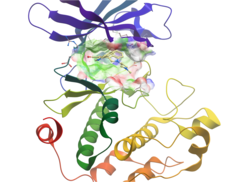Kinase Modeling and Drug Discovery |
 Protein kinases are key drug targets for a number of health problems. The ATP binding pocket is characterized by a hinge region between the N and C-terminals, a helix which moves in and out of the pocket depending on activation state, a flexible glycine rich loop and a region called DFG which can move in and out of the pocket. Therefore modeling the structure of protein kinases and the binding pose of their ligand needs to be done with great care and with the flexibility of the binding pocket in mind. By using ICM-Pro Kufareva et al (2008) developed a method for modeling the DFG-out form of the receptor which usually binds more specific ligands. In 2004 Cavasotto and Abagyan presented a method to incorporate flexibility into the ligand binding site of kinases. This method was used in the discovery of novel EGFR inhibitors with antiproliferative activity against cancer cells.
Protein kinases are key drug targets for a number of health problems. The ATP binding pocket is characterized by a hinge region between the N and C-terminals, a helix which moves in and out of the pocket depending on activation state, a flexible glycine rich loop and a region called DFG which can move in and out of the pocket. Therefore modeling the structure of protein kinases and the binding pose of their ligand needs to be done with great care and with the flexibility of the binding pocket in mind. By using ICM-Pro Kufareva et al (2008) developed a method for modeling the DFG-out form of the receptor which usually binds more specific ligands. In 2004 Cavasotto and Abagyan presented a method to incorporate flexibility into the ligand binding site of kinases. This method was used in the discovery of novel EGFR inhibitors with antiproliferative activity against cancer cells.
Kufareva I, Abagyan R. Type-II kinase inhibitor docking, screening, and profiling using modified structures of active kinase states. J. Med. Chem 2008 Dec;51(24):7921-7932.
Cavasotto, C.N. and Abagyan, R.A. Protein Flexibility in Ligand Docking and Virtual Screening To Protein Kinases J. Mol. Biol. Mar 12; 337(1): 209-25
Cavasotto CN, Ortiz MA, Abagyan RA, Piedrafita FJ. In silico identification of novel EGFR inhibitors with antiproliferative activity against cancer cells. Bioorg Med Chem Lett. 2006 Apr 1;16(7):1969-74.